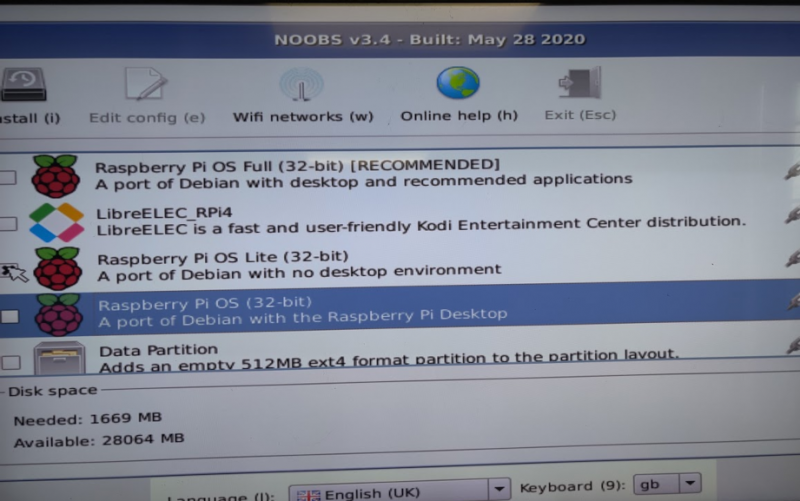
- RASPBERRY PI VMWARE THIN CLIENT OS FREE HOW TO
- RASPBERRY PI VMWARE THIN CLIENT OS FREE ANDROID
- RASPBERRY PI VMWARE THIN CLIENT OS FREE PASSWORD
- RASPBERRY PI VMWARE THIN CLIENT OS FREE DOWNLOAD
- RASPBERRY PI VMWARE THIN CLIENT OS FREE WINDOWS
RASPBERRY PI VMWARE THIN CLIENT OS FREE ANDROID
Otherwise you may experience high packet loss, which is bad for the Android Transporter. If you connect both devices to your home router please make sure that the Wi-Fi transmitting power of your router is set to high. The Wi-Fi hotspot may have the advantage that the Android Transporter has its own dedicated network to minimize the latency jitter during screen mirroring.
RASPBERRY PI VMWARE THIN CLIENT OS FREE PASSWORD
The network name of the Wi-Fi hotspot is RaspberryPiAP and the default password is E.S.R.Labs. If you want to make use of the Wi-Fi hotspot plug in the stick before the Raspberry Pi starts up. It works well with both Wi-Fi sticks except that we occasionally had some power consumption issues with the Asus device. We tested the Wi-Fi hotspot with the Netgear N150 Microadapter and with the Asus N13 Wi-Fi Stick. The Wi-Fi hotspot works with USB Wi-Fi adapters that are supported by the Realtek rtl8192cu Linux driver. Both scenarios require the Raspberry Pi to be plugged into your home router. You can either connect both devices to your home router or you can make use of the Raspberry Pi Wi-Fi hotspot. Next, you have to set up the networking between the two devices. For more information on flashing the Raspberry Pi see the Embedded Linux Wiki page for the Raspberry Pi. Substitute /dev/sdX with the real SD card device name. Insert an SD card into your card reader and flash the firmware image using the dd utility: sudo dd bs=1M if=esrlabs-rpi-android-transporter-.img of=/dev/sdX. Then you can flash the original firmware image using the same instructions that you used to flash the Android Transporter firmware image.ĭownload the Android Transporter firmware for the Raspberry Pi and unpack it.
RASPBERRY PI VMWARE THIN CLIENT OS FREE DOWNLOAD
To switch back to the original Nexus 7 firmware image you should first download it from Google’s factory images site. Be aware that the fastboot utility has to be available in the PATH environment for the flash script. In the Android-Transporter directory you will find the flash script, which is called flash-all.sh. Reboot your Nexus 7 device into the bootloader using adb reboot bootloader. Now unlock it with the fastboot oem unlock command.ĭownload the Android Transporter firmware for the Asus Nexus 7 and unpack it. Unlocking the bootloader is done by getting the device into the bootloader using the adb reboot bootloader command.
RASPBERRY PI VMWARE THIN CLIENT OS FREE HOW TO
Just search the Internet for instructions how to install this tools.
RASPBERRY PI VMWARE THIN CLIENT OS FREE WINDOWS
On Microsoft Windows you will also need Google’s USB drivers. This will void your device warranty and it will also do a factory reset! Next, unlock the bootloader of your Nexus 7 device. Raw image (404 error from their own website) Xfce, LXQt, Mate, KDE, None - depends on spin None / Optional minimal LXDE with dietpi-software installer. Optional installer (dietpi-software) for popular, "ready to run", optimized programs unique to all Pi Models(Kodi/RetroPie etc). There is some information on the news groups that "hard float" optimization can speed up floating point operating up to 10x, please read detailed discussion on the Raspberry Pi forums.Ĭomparison Operating Systems for Raspberry Pi models A and B

The official Raspberry Pi distributions are now optimized for ARMv6 and for "hard float" which should have better performance on certain CPU intensive tasks. Therefore, it did not make use of the Pi's processor's floating point hardware - reducing the Pi's performance during floating point intensive applications - or the advanced instructions of the ARMv6 CPU. The foundation felt necessary to use the existing Debian port for less-capable ARM devices due to time and resource constraints during development of the Raspberry Pi. The Debian Squeeze image originally issued by the Raspberry Pi foundation as the recommended distribution used "soft float" settings. Programming - programming languages that might be used on the Raspberry Pi. Performance - measures of the Raspberry Pi's performance. Kernel Compilation - advice on compiling a kernel. Distributions - operating systems and development environments for the Raspberry Pi.


 0 kommentar(er)
0 kommentar(er)
